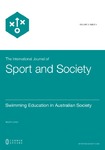Swimming education in Australian society.
| dc.contributor.author | Lynch, TJ | en |
| dc.contributor.editor | Gilbert,, K | en |
| dc.date.accessioned | 2015-12-23T19:57:05Z | |
| dc.date.accessioned | 2016-10-09T04:37:56Z | |
| dc.date.accessioned | 2016-10-09T04:39:07Z | |
| dc.date.accessioned | 2016-10-09T04:49:16Z | |
| dc.date.available | 2015-12-23T19:57:05Z | |
| dc.date.available | 2016-10-09T04:37:56Z | |
| dc.date.available | 2016-10-09T04:39:07Z | |
| dc.date.available | 2016-10-09T04:49:16Z | |
| dc.date.issued | 2014-01-31 | en |
| dc.identifier.issn | 2152-7857 | en |
| dc.identifier.uri | http://hdl.handle.net/10026.1/6309 | |
| dc.description.abstract |
Abstract: The purpose of this paper is to explore a community swimming program using autoethnography qualitative research. Autoethnography is an approach to research and writing that seeks to describe and systematically analyze (graphy) personal experience (auto) in order to understand cultural experience (ethno) (Ellis 2004; Holman Jones 2005). Through childhood reflection of lived swimming experiences, and adult life reflection of lived swimming teaching experiences as a primary school teacher, health and physical education (HPE) specialist teacher and teacher educator, the author, illustrates how aquatic practices and education has shaped his belief, and consequently his drive to initiate a community swimming program. Furthermore, through this illustration, the reader is invited to enter the world of the author as a program pioneer, and share examination of dynamics involved in initiating opportunities for collaboratively developing swimming ability and confidence in primary school children, pre-service teachers and classroom teachers. More specifically, this involves critical analysis of course preparation, participant benefits and barriers during a collaborative swimming education process within Australian society. | en |
| dc.format.extent | 197 - 207 (11) | en |
| dc.language | English | en |
| dc.language.iso | English | en |
| dc.publisher | The Sport Collection, CG Publisher | en |
| dc.relation.replaces | http://hdl.handle.net/10026.1/3982 | |
| dc.relation.replaces | 10026.1/3982 | |
| dc.relation.replaces | http://hdl.handle.net/10026.1/6300 | |
| dc.relation.replaces | 10026.1/6300 | |
| dc.relation.replaces | http://hdl.handle.net/10026.1/6301 | |
| dc.relation.replaces | 10026.1/6301 | |
| dc.subject | Collaboration | en |
| dc.subject | Swimming, | en |
| dc.subject | Water Safety, | en |
| dc.subject | Health and Physical Education, | en |
| dc.title | Swimming education in Australian society. | en |
| dc.type | Journal Article | |
| plymouth.author-url | http://media.wix.com/ugd/842c5e_cfdc4d5be98245c5a90837a72b879557.pdf | en |
| plymouth.edition | 1 | en |
| plymouth.issue | 3 | en |
| plymouth.volume | 4 | en |
| plymouth.publisher-url | http://ijr.cgpublisher.com/product/pub.191/prod.184 | en |
| plymouth.publication-status | Published | en |
| plymouth.journal | The International Journal of Sport and Society | en |
| plymouth.organisational-group | /Plymouth | |
| dc.publisher.place | Champaign, Illinois, USA | en |
| dcterms.dateAccepted | 2012-11-02 | en |
| dc.rights.embargoperiod | No embargo | en |
| rioxxterms.licenseref.uri | http://www.rioxx.net/licenses/all-rights-reserved | en |
| rioxxterms.licenseref.startdate | 2014-01-31 | en |
| rioxxterms.type | Journal Article/Review | en |
| plymouth.oa-location | http://media.wix.com/ugd/842c5e_cfdc4d5be98245c5a90837a72b879557.pdf | en |


